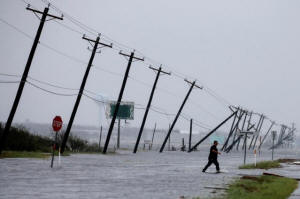U.S. payrolls shrink in September after Hurricanes
Harvey, Irma
 Send a link to a friend
Send a link to a friend
 [October 07, 2017]
By Lucia Mutikani [October 07, 2017]
By Lucia Mutikani
WASHINGTON (Reuters) - U.S. employment fell
in September for the first time in seven years as Hurricanes Harvey and
Irma left displaced workers temporarily unemployed and delayed hiring,
the latest indication that the storms undercut economic activity in the
third quarter.
The Labor Department said on Friday nonfarm payrolls decreased by 33,000
jobs last month amid a record drop in employment in the leisure and
hospitality sector. The decline in payrolls was the first since
September 2010.
The department said Harvey and Irma, which wreaked havoc in Texas and
Florida in late August and early September, reduced employment last
month. But underlying details of the closely watched employment report
were upbeat.
The unemployment rate hit a more than 16-1/2-year low of 4.2 percent and
annual wage growth accelerated to 2.9 percent.

"Investors will find solace in a whole host of other labor market
indicators that reveal an underlying labor market that continues to show
evidence of resilience and continued tightening," said Scott Anderson,
chief U.S. economist at Bank of the West in San Francisco.
Economists had forecast payrolls increasing 90,000 in September.
Payrolls are calculated from a survey of employers, which treats any
worker who was not paid for any part of the pay period that includes the
12th of the month as unemployed.
Many of the dislocated people will probably return to work. That,
together with rebuilding and clean-up is expected to boost job growth in
the coming months.
Leisure and hospitality payrolls plunged 111,000, the most since records
started in 1939, as employment at restaurants and bars fell 104,700.
There were also decreases in retail and manufacturing employment last
month.
The economy created 13,000 more jobs than previously reported in August.
Harvey and Irma did not have an impact on the unemployment rate, which
fell two-tenths of a percentage point from August to the lowest since
February 2001. The smaller survey of households from which the jobless
rate is derived treats persons as employed regardless of whether they
missed work during the reference week and were unpaid as result.
The decrease in the unemployment rate reflected a 906,000 surge in
household employment, which eclipsed a 575,000 increase in the labor
force.
The dollar initially rose against a basket of currencies as investors
focused on the jobless rate and wages, before surrendering gains to
trade little changed. Prices for U.S. Treasuries fell as did stocks on
Wall Street.

DISRUPTIONS BOOST WAGES
Underscoring the disruptive impact of the hurricanes, the household
survey showed 1.5 million workers stayed at home in September because of
the bad weather, the most since January 1996. About 2.9 million people
worked part-time, the largest number since February 2014.
[to top of second column] |

A man walks through floods waters and onto the main road after
surveying his property which was hit by Hurricane Harvey in
Rockport, Texas, U.S. August 26, 2017. REUTERS/Adrees Latif

The length of the average workweek was unchanged at 34.4 hours. With the
hurricane-driven temporary unemployment concentrated in the low-paying retail
and leisure and hospitality industries, average hourly earnings jumped 12 cents
or 0.5 percent in September after rising 0.2 percent in August.
The annual increase in wages in September was the largest since December 2016
and followed an upwardly revised 2.7 percent rise in August. The revision to
August's annual increase from 2.5 percent raised hope that wage growth was
finally picking up.
The unemployment rate is now below the Federal Reserve's median average forecast
for the fourth quarter.
Strong wage gains and shrinking labor market slack left financial markets almost
fully pricing in a December interest rate increase from the U.S. central bank.
Fed Chair Janet Yellen cautioned last month that the hurricanes could
"substantially" weigh on September job growth, but expected the effects would
"unwind relatively quickly."
"The Fed has been hyper-focused on wage growth, so the above-average increase
will be a welcome relief, even if there is some storm impact embedded in the
number," said Marvin Loh, senior global markets strategist at BNY Mellon in
Boston. "We think that the report strengthens the Fed's December hike hand."
The Fed said last month it expected "labor market conditions will strengthen
somewhat further."
The Fed left interest rates unchanged in September, but signaled it expected one
more hike by the end of the year. It has increased borrowing costs twice this
year.

The employment report added to August consumer spending, industrial production,
homebuilding and home sales data in suggesting that the hurricanes will dent
economic growth in the third quarter.
Economists estimate that the back-to-back storms, including Hurricane Maria
which destroyed infrastructure in Puerto Rico last month, could shave at least
six-tenths of a percentage point from third-quarter gross domestic product.
Growth estimates for the July-September period are as low as a 1.8 percent
annualized rate. The economy grew at a 3.1 percent rate in the second quarter.
Private payrolls fell by 40,000 jobs, the first drop since February 2010.
Manufacturing employment slipped by 1,000 jobs pulled down by declines at motor
vehicle assembly and chemical plants as well as textile mills.
Retail employment fell by 2,900 jobs as food stores payrolls tumbled 6,900.
There were also declines in employment at department stores. Construction
payrolls rose 8,000 in September as a 3,900 drop in jobs at homebuilding sites
was offset by increases elsewhere.
(Reporting by Lucia Mutikani; Editing by Andrea Ricci)
[© 2017 Thomson Reuters. All rights
reserved.] Copyright 2017 Reuters. All rights reserved. This material may not be published,
broadcast, rewritten or redistributed. |